To re-cap “The Interview” Part 1 (click here to recap), I interviewed Jeff (on a phone call) to get an idea of what “is” SIM Racing, how he got “into it” and what its like. Jeff suggested that the best way to get an idea of what SIM is all about would be to “try it”. So, I dropped in on Jeff at his house to get a look at the equipment and give it a try. What follows, aka “The Interview, Part 2” is a follow up on what all the buzz is about.
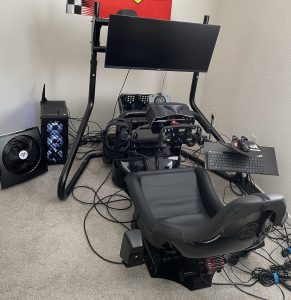 We sat down for Jeff to go over his impressions of doing laps, the detail redering and the complexity of doing a race. But before that, lets take a look at Jeff’s “cockpit” — SIM racers call it their “rig”. For the record, I like my term “cockpit” better! Jeff calls his cockpit an “intermediate level” system, with a steering wheel (actually a yoke type that is used in GT and Formula cars of late!) coupled to a “force feedback” base module to provide tactile steering feedback, a pedal set that portions brake feel, a screen (for general set up) and a VR goggle set for actual driving, a seat with an “Butt Kicker” — not my term — that provides physical feedback to track imperfections and traction loss. It is sort of a sub-woofer but with no sound and all of the shaking.
We sat down for Jeff to go over his impressions of doing laps, the detail redering and the complexity of doing a race. But before that, lets take a look at Jeff’s “cockpit” — SIM racers call it their “rig”. For the record, I like my term “cockpit” better! Jeff calls his cockpit an “intermediate level” system, with a steering wheel (actually a yoke type that is used in GT and Formula cars of late!) coupled to a “force feedback” base module to provide tactile steering feedback, a pedal set that portions brake feel, a screen (for general set up) and a VR goggle set for actual driving, a seat with an “Butt Kicker” — not my term — that provides physical feedback to track imperfections and traction loss. It is sort of a sub-woofer but with no sound and all of the shaking.
The computer is a “windows” based system with a powerful graphics card, needed to provide the renderings of the track and other cars in “your” race. Unfortunately, it has to be a “PC” and not an iMac because of the iRacing program architecture. The PCA experts claimed that Apple products running “bootcamp” can work, but experience is that it is either totally buggy or inadequate. Sorry Apple fans!
Jeff does not use a “shifter lever” since his “cars” are a double clutch and he uses the steering wheel paddles, very similar to what’s in the actual cars.
An overall look at the system is to the right.
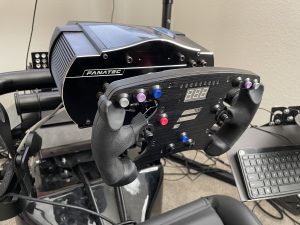 A closer look at the steering wheel is shown, left. The yoke has all sorts of buttons on it that enables functions like, “push to talk” when in a race and you talk to the stewards or team members, brake bias, pit lane speed limiter, etc. all typical functions that are found on actual GT/formula “wheels”. The module the wheel is attached to is the “force feedback’ module, this one a product of Fanatec. The types of force feedback modules range from: gear driven (basic), belt driven (intermediate) and “direct” drive (upgrade). The forces provided go up as the module goes from gear, to belt to direct drive. The Fanatec drives allow the wheel to dismount — ever see F1 drivers get out of their car, they unmount their steering wheel before climbing out of their cockpit, replacing them when they leave the car? Same functionality here.
A closer look at the steering wheel is shown, left. The yoke has all sorts of buttons on it that enables functions like, “push to talk” when in a race and you talk to the stewards or team members, brake bias, pit lane speed limiter, etc. all typical functions that are found on actual GT/formula “wheels”. The module the wheel is attached to is the “force feedback’ module, this one a product of Fanatec. The types of force feedback modules range from: gear driven (basic), belt driven (intermediate) and “direct” drive (upgrade). The forces provided go up as the module goes from gear, to belt to direct drive. The Fanatec drives allow the wheel to dismount — ever see F1 drivers get out of their car, they unmount their steering wheel before climbing out of their cockpit, replacing them when they leave the car? Same functionality here.
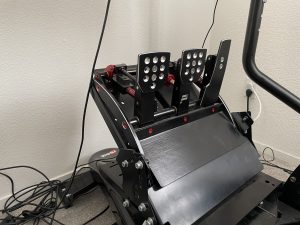
The next critical part of the cockpit is the “pedal module”. Entry level pedal sets often are essentially “switches”… as in ‘gas on- gas off”, “brake on / brake off”. Think Atari games from 20 years ago!
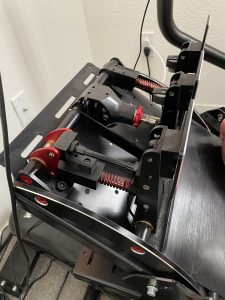 Here are photos of Jeff’s pedal module. Absolutely needed are “load cell” pedals where the amount of “gas on” or “brake on” can be modulated/feathered and not just WOT (that’s Wide Open Throttle). A closer look at the load cell aspect of these pedals is shown to the left. The “load” of the pedals can be adjusted from firm to compliant. Jeff likes “firm”. Another note from the real world. F1 brake pedals do not “move” — they are stationary “load cells” where the amount of brake force is dictated by the driver pressing on the load cell, press harder, stop faster! Jeff’s system for SIM racing is pretty much the same thing.
Here are photos of Jeff’s pedal module. Absolutely needed are “load cell” pedals where the amount of “gas on” or “brake on” can be modulated/feathered and not just WOT (that’s Wide Open Throttle). A closer look at the load cell aspect of these pedals is shown to the left. The “load” of the pedals can be adjusted from firm to compliant. Jeff likes “firm”. Another note from the real world. F1 brake pedals do not “move” — they are stationary “load cells” where the amount of brake force is dictated by the driver pressing on the load cell, press harder, stop faster! Jeff’s system for SIM racing is pretty much the same thing.
So, that’s the system. But what is it like to “drive”?
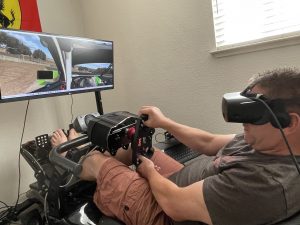 Jeff set up a test drive “session” to demonstrate what it looks like in action. I picked Laguna Seca since I’ve done DE’s there in my Cayman(s) for several years so I could compare what Jeff was “doing” in the virtual world to my memories on track. Here is a photo of Jeff on a “hot lap”, using his VR goggles, but showing the same views on the screen — so I could watch.
Jeff set up a test drive “session” to demonstrate what it looks like in action. I picked Laguna Seca since I’ve done DE’s there in my Cayman(s) for several years so I could compare what Jeff was “doing” in the virtual world to my memories on track. Here is a photo of Jeff on a “hot lap”, using his VR goggles, but showing the same views on the screen — so I could watch.
This is where the “demo” got interesting. I can verify that Jeff “knows” Laguna Seca. He positioned his (virtual) GT3R on all the proper spots, turned in onto the corners where he should have, hit the apexes where he should have (not early, but smoothly and on time), tracked out to the right spots on the exits and was in tune with the “flow” of the track. To my eyes, Jeff was more in an “attack mode”, getting to and from the corners a lot faster than I’m used to seeing through the windscreen of my Cayman. The iRacing system was allowing much more acceleration than I’m used to, again in my Cayman, with greater speed through the corners. After the hot lap, Jeff estimated a lap time of about 1:30. Now for reference, the images I have through the windscreen of my Cayman are of @ a 1:55 lap (in my defense, I brake early in line with my “85% and have fun” mind set and I have to get off the throttle after turn T5 as I pass the “sound test station” — my GTS easily breaks 92dB levels if I pass the test station at WOT. I’ve been pulled in off the track a couple times for “breaking the sound barrier”. UGH)
So, was he actually “driving” Laguna Seca? While I’m sure there will always be doubters, but lets look at this from the following perspective. “Driving” involves manipulating car controls (steering, breaking, throttling) in response to the road ahead. Jeff was doing pretty much just that! Based on the view out of “his” windscreen, he was positioning his “car” on the road, accelerating and braking, turning in the corners to stay on the road — the same things I do when on Laguna Seca in my Cayman GTS. He was reacting to changes in tire pressure (started on cold tires which heated up for more grip, just like an outlap waiting for my tire pressure/temperature to come up.) He was reacting to carrying too much speed into a corner and tracking out on the berms, yep, I’ve done that. Differences? Jeff can do this at 99.9% of capabilities without hesitation of balling up a physical car. He can jump in for some hot laps after work before dinner instead of burning up a full day to drive to the track, do tech, do driver’s meetings (again), re-torque wheels and check tire pressures, make sure the tank is full of gas, and without getting way too hot with 95deg days!
But what does it actually “feel” like?
It’s my turn at the wheel of Jeff’s “car”. I climb into the seat and find the pedals. For me, the seating position was too reclined. I’m just used to a more upright seating position with my “wheel” and arms more “chest” high. But, I can handle it.
Next came the VR goggles. W H O O A… that was an experience. The detail that was “visible” to my eyes was just amazing and had depth of field! Near things, like the steering wheel, looked close, the track out of the window looked “outside” the car. I’m really new at this so I plan on taking a couple laps like in 2nd gear just to synchronize what I’m seeing with steering effort. I click into 1st gear, and there is a thump to the seat, just like I would expect a GT3R’s gear engagement to feel like ( cool ! ). I pull out of the hot pit onto the track access road (its a wide “one lane” lane that follows the Andretti Hairpin (aka Turn 2) and pull into the track — slowly! For me the steering was a bit disconnected with what I am seeing… then it hit me.. I’m not even into lap one and I’m motion sick. Apparently, the VR experience is not for everyone! Just like my experience at Porsche Experience Center LA in their simulator — except there I kept pushing for another 5 or 8 minutes — until I had to run to the Men’s Room and … throw up! UGH!
Jeff suggested I just use the “screen”, reset the program and I set out back on track. I got a bit off the pit exit road so I just tugged the wheel right and pulled straight onto the track at Turn 1, getting the full effect on the wheel and the seat vibrations responding to a bit of “off roading” to get to Turn 1. I got around the track a couple times, had to do some corrective steering coming out of Turn 5 (very, very life like response!) I never did get the braking down. Clearly the program was expecting more “speed” before I hit the brakes… in 2nd gear I should have just piloted around the track without braking, the program imputed more than enough grip to do so.
But the deal was done, my queasy tummy was not going to recover without stopping the “event”.
So, while my ego was a bit bruised by susceptibility to video nausea, I came away with an appreciation of the “driving” skill needed to turn a 1:30 lap at LS, to the realism of the presented visuals and the computations behind the screen to replicate an accurate reflection of driving a high performance Porsche. I didn’t get to experience the programing dealing with multiple cars (remember fields are generally in the 30 to 40 cars!) in a race and all the computational power to handle the race action, but I would expect it to be equally as realistic as our “test drive”. If I had a stronger stomach, I think I would really enjoy to do this. Then again, if I had a stronger stomach I might push my Cayman to 99% on my DE’s… Its all related, isn’t it?
